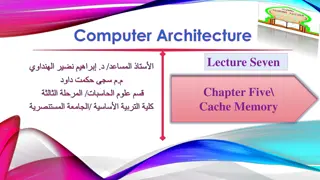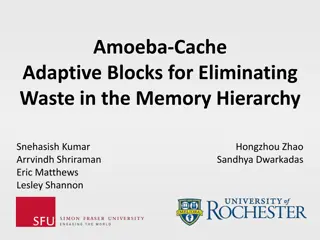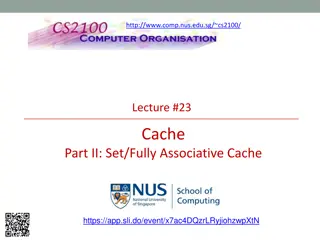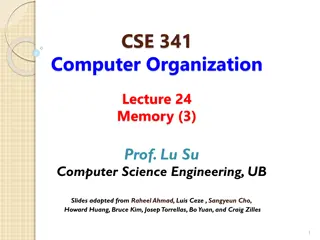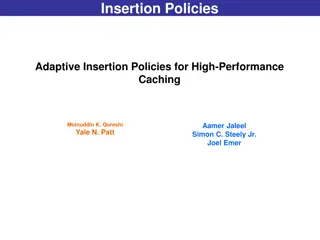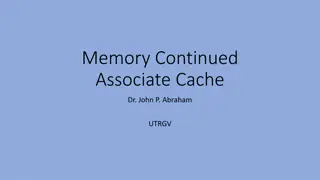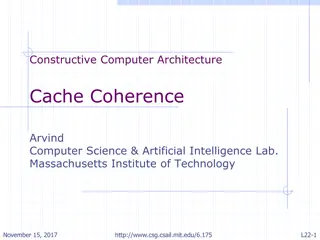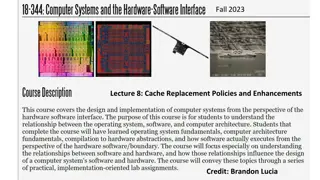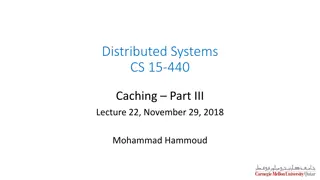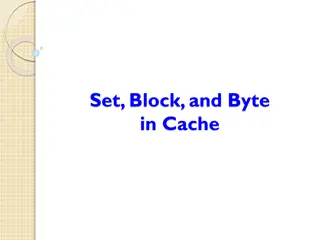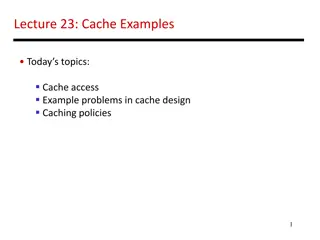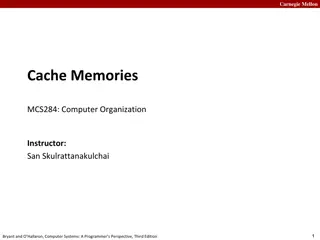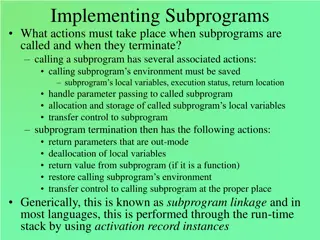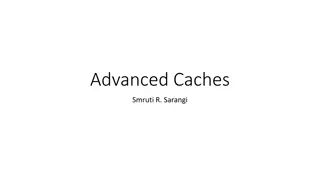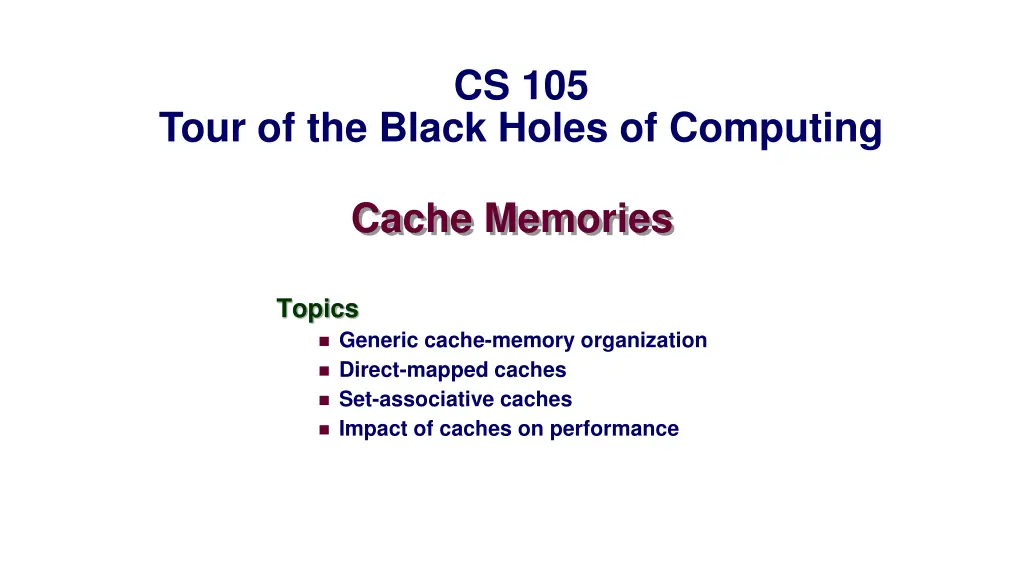
Understanding Cache Memories and Locality Principles in Computing
Explore the concepts of cache memories, direct-mapped and set-associative caches, and the impact of caches on performance. Learn about the locality principle and how it influences program behavior, memory access patterns, and array layout in memory.
Download Presentation

Please find below an Image/Link to download the presentation.
The content on the website is provided AS IS for your information and personal use only. It may not be sold, licensed, or shared on other websites without obtaining consent from the author. If you encounter any issues during the download, it is possible that the publisher has removed the file from their server.
You are allowed to download the files provided on this website for personal or commercial use, subject to the condition that they are used lawfully. All files are the property of their respective owners.
The content on the website is provided AS IS for your information and personal use only. It may not be sold, licensed, or shared on other websites without obtaining consent from the author.
E N D
Presentation Transcript
CS 105 Tour of the Black Holes of Computing Cache Memories Topics Generic cache-memory organization Direct-mapped caches Set-associative caches Impact of caches on performance
Typical Speeds Registers: 1 clock (= 400 ps on 2.5 GHz processor) to get 8 bytes DRAM: 100 300 clocks to get 32 64 bytes (4 or 8 longs) SSD: 75,000 clocks and up (high variance), 4096 bytes Hard drive: 5,000,000 25,000,000 clocks, 4096 bytes Ouch! Ouch! CS105 2
Locality Principle of Locality: Programs tend to use data and instructions with addresses equal or near to those they have used recently Temporal locality: Recently referenced items are likely to be referenced again in the near future Spatial locality: Items with nearby addresses tend to be referenced close together in time CS105 3
Locality Example sum = 0; for (i = 0; i < n; i++) sum += a[i]; return sum; Data references Reference array elements in succession (stride-1 reference pattern). Reference variable sum each iteration. Spatial locality Temporal locality Instruction references Reference instructions in sequence. Cycle through loop repeatedly. Spatial locality Temporal locality CS105 4
Layout of C Arrays in Memory (review) C arrays allocated in row-major order Each row in contiguous memory locations Stepping through columns in one row: for (i = 0; i < N; i++) sum += a[0][i]; Accesses successive elements Stepping through rows in one column: for (i = 0; i < n; i++) sum += a[i][0]; Accesses distant elements No spatial locality! CS105 5
Qualitative Estimates of Locality Claim: Being able to look at code and get a qualitative sense of its locality is a key skill for a professional programmer. Question: Does this function have good locality with respect to array a? int sum_array_rows(int a[M][N]) { int i, j, sum = 0; for (i = 0; i < M; i++) for (j = 0; j < N; j++) sum += a[i][j]; return sum; } CS105 6
Locality Example Question: Does this function have good locality with respect to array a? int sum_array_cols(int a[M][N]) { int i, j, sum = 0; for (j = 0; j < N; j++) for (i = 0; i < M; i++) sum += a[i][j]; return sum; } CS105 7
Cache Memories Cache memories are small, fast SRAM-based memories managed automatically in hardware Hold frequently accessed blocks of main memory CPU looks first for data in cache, then in main memory Typical system structure: CPU chip Register file Cache memory ALU System bus Memory bus Main memory I/O Bus interface bridge CS105 12
Typical Speeds Registers: 1 clock (= 400 ps on 2.5 GHz processor) to get 8 bytes Level-1 (L1) cache: 3 5 clocks to fetch 8 bytes L2 cache: 10 20 clocks, 32 64 bytes L3 cache: 20 100 clocks (multiple cores make things slower), 32 64 bytes DRAM: 100 300 clocks, 32 64 bytes SSD: 75,000 clocks and up (high variance), 4096 bytes Hard drive: 5,000,000 25,000,000 clocks, 4096 bytes CS105 13
General Cache Concepts Smaller, faster, more expensive memory caches a subset of the blocks Cache 8 4 9 14 10 3 Data is copied in block-sized transfer units 4 10 Larger, slower, cheaper memory viewed as partitioned into blocks Memory 0 1 2 3 4 4 5 6 7 8 9 10 10 11 12 13 14 15 CS105 14
General Cache Concepts: Hit Request: 14 Data in block b is needed Block b is in cache: Hit! Cache 8 9 14 14 3 Memory 0 1 2 3 4 5 6 7 8 9 10 11 12 13 14 15 CS105 15
General Cache Concepts: Miss Request: 12 Data in block b is needed Block b is not in cache: Cache 8 9 12 14 3 Miss! Block b is fetched from Request: 12 12 memory Block b is stored in cache Memory 0 1 2 3 Placement policy: determines where b goes 4 5 6 7 Replacement policy: determines which block gets evicted (victim) 8 9 10 11 12 12 13 14 15 CS105 16
General Caching Concepts: Types of Cache Misses Cold (compulsory) miss Cold misses occur because the cache is empty. Conflict miss Most caches limit blocks from level k+1 to going into a small subset (sometimes a singleton) of the block positions at level k E.g. block i from level k+1 must go in block (i mod 4) at level k Conflict misses occur when the level k cache is large enough, but multiple data objects all map to the same level k block E.g. referencing blocks 0, 8, 0, 8, 0, 8, ... would miss every time Capacity miss Occurs when set of active cache blocks (working set) is larger than the cache CS105 17
General Cache Organization (S, E, B) Not always power of 2! E lines per set set Cache size: C = S x E x B data bytes line Set # hash code S = 2s sets Tag hash key B-1 tag 0 1 2 v valid bit CS105 18 B = 2b bytes per cache block (the data)
E-Way Set Assoc. Cache Read Locate set Check if any line in set has matching tag Yes + line valid: hit Locate data starting at offset E lines per set Address of word: b bits t bits s bits S = 2s sets set index block offset tag data begins at this offset tag B-1 v 0 1 2 valid bit CS105 19 B = 2b bytes per cache block (the data)
Example: Direct Mapped Cache (E = 1) Direct mapped: One line per set Assume cache block size 8 bytes Address of int: v tag 0 1 2 3 4 5 6 7 100 t bits 0 01 v tag 0 1 2 3 4 5 6 7 Find set S = 2s sets v tag 0 1 2 3 4 5 6 7 tag v 0 1 2 3 4 5 6 7 CS105 20
Example: Direct Mapped Cache (E = 1) Direct mapped: One line per set Assume cache block size 8 bytes Address of int: Valid? + Match: both yes = hit 100 t bits 0 01 v tag tag 0 1 2 3 4 5 6 7 Block offset CS105 21
Example: Direct Mapped Cache (E = 1) Direct mapped: One line per set Assume cache block size 8 bytes Address of int: Valid? + Match: both yes = hit 100 t bits 0 01 v tag 0 1 2 3 4 5 6 7 Block offset int (4 Bytes) is here If tag doesn t match: old line is evicted and replaced CS105 22
Direct-Mapped Cache Simulation t=1 s=2 xx b=1 x M=16 bytes (4-bit addresses), B=2 bytes/block, S=4 sets, E=1 Blocks/set x Address trace (reads, one byte per read): 0 [00002], 1 [00012], 7 [01112], 8 [10002], 0 [00002] miss hit miss miss miss v Tag Block M[0-1] M[8-9] M[0-1] 0 1 1 1 ? 0 1 0 ? Set 0 Set 1 Set 2 Set 3 1 0 M[6-7] CS105 23
E-way Set-Associative Cache (Here: E = 2) E = 2: Two lines per set Assume cache block size 8 bytes Address of short int: 100 t bits 0 01 v tag 0 1 2 3 4 5 6 7 v tag 0 1 2 3 4 5 6 7 Find set v tag 0 1 2 3 4 5 6 7 v tag 0 1 2 3 4 5 6 7 v tag 0 1 2 3 4 5 6 7 v tag 0 1 2 3 4 5 6 7 v tag 0 1 2 3 4 5 6 7 v tag 0 1 2 3 4 5 6 7 CS105 24
E-way Set-Associative Cache (Here: E = 2) E = 2: Two lines per set Assume cache block size 8 bytes Address of short int: 100 t bits 0 01 Compare both Valid? + Match: both yes = hit v tag tag 0 1 2 3 4 5 6 7 v tag 0 1 2 3 4 5 6 7 Block offset CS105 25
E-way Set-Associative Cache (Here: E = 2) E = 2: Two lines per set Assume cache block size 8 bytes Address of short int: 100 t bits 0 01 Compare both Valid? + Match: both yes = hit v tag 0 1 2 3 4 5 6 7 v tag 0 1 2 3 4 5 6 7 block offset short int (2 bytes) is here No match: One line in set is selected for eviction and replacement Replacement policies: random, least recently used (LRU), CS105 26
2-Way Set-Associative Cache Simulation t=2 s=1 x b=1 x M=16 byte addresses, B=2 bytes/block, S=2 sets, E=2 blocks/set xx Address trace (reads, one byte per read): 0 [00002], 1 [00012], 7 [01112], 8 [10002], 0 [00002] miss hit miss miss hit v Tag Block 0 0 1 ? 00 10 ? M[0-1] M[8-9] 1 Set 0 0 0 1 01 M[6-7] Set 1 CS105 27
What About Writes? Multiple copies of data exist: L1, L2, L3, Main Memory, Disk What to do on a write hit? Write-through (write immediately to memory) Write-back (defer write to memory until replacement of line) Need a dirty bit (line different from memory or not) What to do on a write miss? Write-allocate (load into cache, update line in cache) Good if more writes to the location follow No-write-allocate (writes straight to memory, does not load into cache) Typical Write-through + No-write-allocate Write-back + Write-allocate CS105 28
Intel Core i7 Cache Hierarchy Processor package Core 0 Core 3 L1 i-cache and d-cache: 32 KB, 8-way, Access: 4 cycles Regs Regs L2 unified cache: 256 KB, 8-way, Access: 10 cycles L1 L1 L1 L1 d-cache i-cache d-cache i-cache L2 unified cache L2 unified cache L3 unified cache: 8 MB, 16-way, Access: 40-75 cycles Block size: 64 bytes for all caches. L3 unified cache (shared by all cores) Motherboard might provide L4 Main memory CS105 29
Cache Performance Metrics Miss Rate Fraction of memory references not found in cache (misses / accesses) = 1 hit rate Typical numbers (in percentages): 3-10% for L1 Can be quite small (e.g., < 1%) for L2, depending on size, etc. Hit Time Time to deliver a line in the cache to the processor Includes time to determine whether line is in the cache Typical numbers: 3-4 clock cycles for L1 ~10 clock cycles for L2 Miss Penalty Additional time required because of a miss Typically 50-200 cycles for main memory CS105 30
Lets Think About Those Numbers Huge difference between a hit and a miss Could be 100x, e.g., for L1 vs. main memory Would you believe 99% hits is twice as good as 97%? Consider: Cache hit time of 1 cycle Miss penalty of 100 cycles Average access time: 97% hits: 1 cycle + 0.03 * 100 cycles = 4 cycles 99% hits: 1 cycle + 0.01 * 100 cycles = 2 cycles This is why miss rate is used instead of hit rate CS105 31
Writing Cache-Friendly Code Make the common case go fast Focus on the inner loops of the core functions Minimize misses in the inner loops Repeated references to variables are good (temporal locality) Stride-1 reference patterns are good (spatial locality) Key idea: Our qualitative notion of locality is quantified by our understanding of cache memories CS105 32
Matrix-Multiplication Example Variable sum held in register Description: Multiply N x N matrices Matrix elements are doubles (8 bytes) O(N3) total operations N reads per source element N values summed per destination But may be able to keep in register /* ijk */ for (i = 0; i < N; i++) { for (j = 0; j < N; j++) { sum = 0.0; for (k = 0; k < N; k++) sum += a[i][k] * b[k][j]; c[i][j] = sum; } } matmult/mm.c CS105 36
Miss-Rate Analysis for Matrix Multiply Assume: Block size = 32B (big enough for four doubles) Matrix dimension (N) is very large Approximate 1/N as 0.0 Cache is not even big enough to hold multiple rows Analysis Method: Look at access pattern of inner loop j j k = x i i k C A B CS105 37
Matrix Multiplication (ijk) /* ijk */ for (i = 0; i < n; i++) { for (j = 0; j < n; j++) { sum = 0.0; for (k = 0; k < n; k++) sum += a[i][k] * b[k][j]; c[i][j] = sum; } } Inner loop: (*,j) (i,j) (i,*) A B C matmult/mm.c Row-wise Column- wise Fixed Misses per inner loop iteration: A B C 0.25 1.0 0.0 CS105 38
Matrix Multiplication (jik) /* jik */ for (j = 0; j < n; j++) { for (i = 0; i < n; i++) { sum = 0.0; for (k = 0; k < n; k++) sum += a[i][k] * b[k][j]; c[i][j] = sum } } Inner loop: (*,j) (i,j) (i,*) A B C matmult/mm.c Row-wise Column- wise Fixed Misses per inner loop iteration: A B C 0.25 1.0 0.0 CS105 39
Matrix Multiplication (ikj) /* ikj */ for (i = 0; i < n; i++) { for (k = 0; k < n; k++) { r = a[i][k]; for (j = 0; j < n; j++) c[i][j] += r * b[k][j]; } } Inner loop: (*,j) (k,*) (i,k) (i,*) A B C matmult/mm.c Fixed Row-wise Row-wise Misses per inner loop iteration: A B C 0.0 0.25 0.25 CS105 40
Matrix Multiplication (jki) /* jki */ for (j = 0; j < n; j++) { for (k = 0; k < n; k++) { r = b[k][j]; for (i = 0; i < n; i++) c[i][j] += a[i][k] * r; } } Inner loop: (*,j) (*,k) (k,j) A B C matmult/mm.c Column- wise Fixed Column- wise Misses per inner loop iteration: A B C 1.0 0.0 1.0 CS105 41
Matrix Multiplication (kij) /* kij */ for (k = 0; k < n; k++) { for (i = 0; i < n; i++) { r = a[i][k]; for (j = 0; j < n; j++) c[i][j] += r * b[k][j]; } } Inner loop: (*,j) (k,*) (i,k) (i,*) A B C matmult/mm.c Fixed Row-wise Row-wise Misses per inner loop iteration: A B C 0.0 0.25 0.25 CS105 42
Matrix Multiplication (kji) /* kji */ for (k = 0; k < n; k++) { for (j = 0; j < n; j++) { r = b[k][j]; for (i = 0; i < n; i++) c[i][j] += a[i][k] * r; } } Inner loop: (*,j) (*,k) (k,j) A B C matmult/mm.c Column- wise Fixed Column- wise Misses per inner loop iteration: A B C 1.0 0.0 1.0 CS105 43
Summary of Matrix Multiplication for (i = 0; i < n; i++) { for (j = 0; j < n; j++) { sum = 0.0; for (k = 0; k < n; k++) sum += a[i][k] * b[k][j]; c[i][j] = sum; } } ijk (& jik): 2 loads, 0 stores Misses/iter = 1.25 for (j = 0; j < n; j++) { for (k = 0; k < n; k++) { r = b[k][j]; for (i = 0; i < n; i++) c[i][j] += a[i][k] * r; } } jki (& kji): 2 loads, 1 store Misses/iter = 2.0 for (k = 0; k < n; k++) { for (i = 0; i < n; i++) { r = a[i][k]; for (j = 0; j < n; j++) c[i][j] += r * b[k][j]; } } kij (& ikj): 2 loads, 1 store Misses/iter = 0.5 CS105 44
Cache Miss Analysis Assume: Matrix elements are doubles Cache block = 8 doubles (64 bytes) Cache size C << N (much smaller than N) n A B C First iteration: n/8 + n = 9n/8 misses = * Afterwards in cache: (schematic) = * 8 wide CS105 46
Cache Miss Analysis Assume: Matrix elements are doubles Cache block = 8 doubles Cache size C << n (much smaller than n) n Second iteration: Again: n/8 + n = 9n/8 misses = * 8 wide Total misses: 9n/8 * n2 = (9/8) * n3 CS105 47
Blocked Matrix Multiplication c = (double *) calloc(sizeof(double), n*n); /* Multiply n x n matrices a and b */ void mmm(double *a, double *b, double *c, int n) { int i, j, k; for (i = 0; i < n; i += B) for (j = 0; j < n; j += B) for (k = 0; k < n; k += B) /* B x B mini matrix multiplications */ for (i1 = i; i1 < i+B; i++) for (j1 = j; j1 < j+B; j++) for (k1 = k; k1 < k+B; k++) c[i1*n + j1] += a[i1*n + k1]*b[k1*n + j1]; } j1 c a b c = + * i1 CS105 48 Block size B x B
Cache Miss Analysis Assume: Cache block = 8 doubles Cache size CS << n (much smaller than n) Three blocks fit into cache: 3B2 < CS First (block) iteration: B2/8 misses for each block 2n/B * B2/8 = nB/4 (omitting matrix C, shown on left) n/B blocks = * Block size B x B Afterwards in cache (schematic) = * CS105 49
Cache Miss Analysis Assume: Cache block = 8 doubles Cache size CS << n (much smaller than n) Three blocks fit into cache: 3B2 < CS Second (block) iteration: Same as first iteration 2n/B * B2/8 = nB/4 n/B blocks = * Total misses: nB/4 * (n/B)2 = n3/(4B) Compare (9/8)n3 for na ve implementation Block size B x B CS105 50
Blocking Summary No blocking: (9/8) * n3 Blocking: 1/(4B) * n3 (plus n2/8 misses for C) Suggest largest possible block size B, but limit 3B2 < C! Reason for dramatic difference: Matrix multiplication has inherent temporal locality: Input data: 3n2, computation 2n3 Every array element used O(n) times! But program has to be written properly CS105 51
Cache Summary Cache memories can have significant performance impact You can write your programs to exploit this! Focus on the inner loops, where bulk of computations and memory accesses occur. Try to maximize spatial locality by reading data objects with sequentially with stride 1. Try to maximize temporal locality by using a data object as often as possible once it s read from memory. CS105 52


